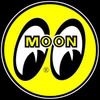Post by scotttansley on Aug 26, 2011 10:33:10 GMT -6
Its a start.

This will be a two part mold. I first puttied up the master using apoxy sculpt. Its a great material for use as a modeling filler and is water based.

I then put some plasticine under it to hold it horizontal and start building up around the master

Keep going till you've block in the plasticine up to where you would want your mold or parting line.

I jab a few holes in the plasticine with the back of a paint brush to help the mold locate itself later. Kind of keys the two parts of the mold together its really easy but essential. Then cut and place some cardboard around the plasticine. hold with rubber band and masking tape.

I then sprayed some release agent and pored in the silicon material. I'm using a silicon called pinkisil from my local Barnes art and fx supplier. Its just a two part silicon you should be able to source something similar in your neck of the woods.

Once set,about half hour, I take the cardboard of but keep it. I'll need toput it back once I remove the plasticine.

Plasticine removed.
There a pic missing here but I basically just put the cardboard back on, sprayed some release agent and pored the other half of silicon. It can be quite tricky to pull the two pieces of silicon apart I usually need to run a knife blade around it a bit to get it apart but once apart its good.

The finished two part mold. I cut a pore hole neat the engine mount and some breather holes either side along the face of the mold halves to allow me to pore the resin in and let the air out. You have to choose the pore hole location in the best place to minimise air pockets. I will be poring the resin in from the top once the two halves are held together with rubber bands and cardboard.

The first resin pore. I use a polyurethane resin that has a duro similar to a hardhat. But any resin will do even clear resin. I usaully dye the resin with some color which helps show up any bubbles that will need filling.

The engine mold is a much simpler type and a "one part" mold. Again I missed a picture but I basically rolled some plasticine flat on the work bench and pressed the two engine halves onto it and pushed a one inch strip of cardboard around them. Then spray mold release and pored silicon in till it covered the parts about a half inch. Wait half an hour and you have a one piece mold. These are easy to pore you just lay it flat and and fill it up to the top with resin.

I placed some brass rod in while the resin was still liquid as the engine cowl will be fixed to these bits.

Ok so for the smaller and thinner undercarriage I'm using a technique that will involve poring the resin in from the bottom. If I make this two part mold like the fuselage it will be too hard to pore resin into such a thin piece. The pore hole will just get blocked and not much if any resin will get into the mold. So I am going to run a tunnel down and under the part so I'm poring into a larger hole. It will run down and accross and come up through the part and when I see resin coming out through the breather hole I know that the mold is full. This technique also seems to have less bubbles as the bubbles tend to stay in the downward vertical pore section of the mold. I think I'll be using this method more often its really effective for nice clean pores.

Look, camera in left hand, cup o silicon poring from right hand. Easy as.

I sliced a few breather holes from the top most bit of the parts to the top of the mold. You can see on the right where I pored in the resin and the 4 breathers on the left. Once I saw resin in the 4 breathers I stop poring. Done.

Wait till set and pull mold apart. You can better see how this mold works with the part still there. Thin parts take a lot longer to cure. The earlier mold of the fuselage could be pulled out after half an hour. But these thinner parts take about two hours to cure hard enough to be safe to pull out.

Some small diameter brass tube flattened at each end drilled and pinned with small rivets into the resin and tailplane.

Bracing made from guitar strings. I wrapped some ultra thin strands of copper wire pulled from small electrical stranded wire to either end of each brace.
Where the brace crosses I use the same small wire wrapped once horizontally then vertically and tied and trimmed with a tiny spot of superglue. This added a great deal more strength to the bracing and looks cool too.

I did the wing bracing the same but with even thinner guitar strings. Mounting the whole thing on this simple wooden jig will help manhandle the thing while im painting and detailing from here on. The wooden supports from the body to the underside of the middle of the top wing are birch wood, as are the outer wing struts. The wing struts have been stained and lacquered and will be masked off when priming.


This will be a two part mold. I first puttied up the master using apoxy sculpt. Its a great material for use as a modeling filler and is water based.

I then put some plasticine under it to hold it horizontal and start building up around the master

Keep going till you've block in the plasticine up to where you would want your mold or parting line.

I jab a few holes in the plasticine with the back of a paint brush to help the mold locate itself later. Kind of keys the two parts of the mold together its really easy but essential. Then cut and place some cardboard around the plasticine. hold with rubber band and masking tape.

I then sprayed some release agent and pored in the silicon material. I'm using a silicon called pinkisil from my local Barnes art and fx supplier. Its just a two part silicon you should be able to source something similar in your neck of the woods.

Once set,about half hour, I take the cardboard of but keep it. I'll need toput it back once I remove the plasticine.

Plasticine removed.
There a pic missing here but I basically just put the cardboard back on, sprayed some release agent and pored the other half of silicon. It can be quite tricky to pull the two pieces of silicon apart I usually need to run a knife blade around it a bit to get it apart but once apart its good.

The finished two part mold. I cut a pore hole neat the engine mount and some breather holes either side along the face of the mold halves to allow me to pore the resin in and let the air out. You have to choose the pore hole location in the best place to minimise air pockets. I will be poring the resin in from the top once the two halves are held together with rubber bands and cardboard.

The first resin pore. I use a polyurethane resin that has a duro similar to a hardhat. But any resin will do even clear resin. I usaully dye the resin with some color which helps show up any bubbles that will need filling.

The engine mold is a much simpler type and a "one part" mold. Again I missed a picture but I basically rolled some plasticine flat on the work bench and pressed the two engine halves onto it and pushed a one inch strip of cardboard around them. Then spray mold release and pored silicon in till it covered the parts about a half inch. Wait half an hour and you have a one piece mold. These are easy to pore you just lay it flat and and fill it up to the top with resin.

I placed some brass rod in while the resin was still liquid as the engine cowl will be fixed to these bits.

Ok so for the smaller and thinner undercarriage I'm using a technique that will involve poring the resin in from the bottom. If I make this two part mold like the fuselage it will be too hard to pore resin into such a thin piece. The pore hole will just get blocked and not much if any resin will get into the mold. So I am going to run a tunnel down and under the part so I'm poring into a larger hole. It will run down and accross and come up through the part and when I see resin coming out through the breather hole I know that the mold is full. This technique also seems to have less bubbles as the bubbles tend to stay in the downward vertical pore section of the mold. I think I'll be using this method more often its really effective for nice clean pores.

Look, camera in left hand, cup o silicon poring from right hand. Easy as.

I sliced a few breather holes from the top most bit of the parts to the top of the mold. You can see on the right where I pored in the resin and the 4 breathers on the left. Once I saw resin in the 4 breathers I stop poring. Done.

Wait till set and pull mold apart. You can better see how this mold works with the part still there. Thin parts take a lot longer to cure. The earlier mold of the fuselage could be pulled out after half an hour. But these thinner parts take about two hours to cure hard enough to be safe to pull out.

Some small diameter brass tube flattened at each end drilled and pinned with small rivets into the resin and tailplane.

Bracing made from guitar strings. I wrapped some ultra thin strands of copper wire pulled from small electrical stranded wire to either end of each brace.
Where the brace crosses I use the same small wire wrapped once horizontally then vertically and tied and trimmed with a tiny spot of superglue. This added a great deal more strength to the bracing and looks cool too.

I did the wing bracing the same but with even thinner guitar strings. Mounting the whole thing on this simple wooden jig will help manhandle the thing while im painting and detailing from here on. The wooden supports from the body to the underside of the middle of the top wing are birch wood, as are the outer wing struts. The wing struts have been stained and lacquered and will be masked off when priming.
















































